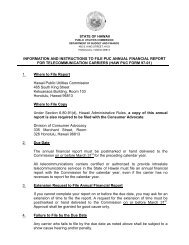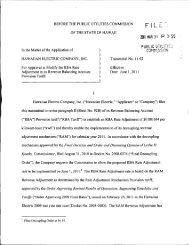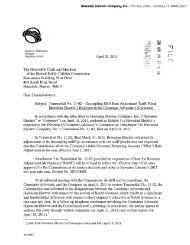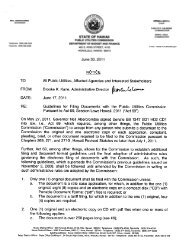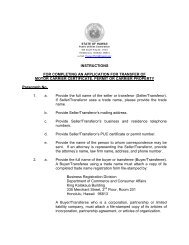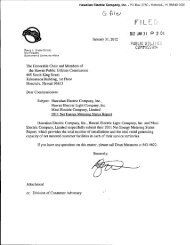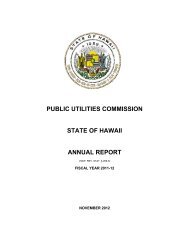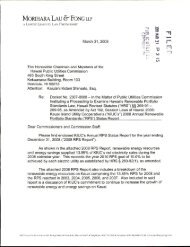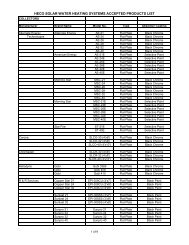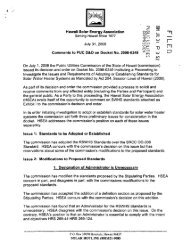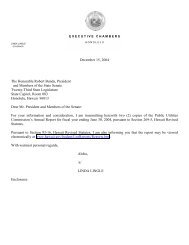PUC Annual ReportâFiscal Year 2004-05 - Public Utilities Commission
PUC Annual ReportâFiscal Year 2004-05 - Public Utilities Commission
PUC Annual ReportâFiscal Year 2004-05 - Public Utilities Commission
Create successful ePaper yourself
Turn your PDF publications into a flip-book with our unique Google optimized e-Paper software.
<strong>Public</strong> <strong>Utilities</strong> <strong>Commission</strong> <strong>Annual</strong> Report <strong>2004</strong>-<strong>05</strong>State of Hawaii Page 93XII.FEDERAL ISSUES AND ACTIVITIES.A. EPA (“U.S. ENVIRONMENTAL PROTECTION AGENCY”)-STATEENERGY EFFICIENCY AND RENEWABLE ENERGY (“EERE”)PROJECTS.In February 20<strong>05</strong>, the <strong>Commission</strong>, through its membership in NARUC, was selected bythe EPA to participate in the newly formed EPA-State EERE Projects. The EPA-State EEREProjects are a joint initiative between state utility regulators from six (6) states and the EPA toexplore ways to encourage use of cost-effective energy efficiency, renewable energy, and cleanenergy resources, while lowering consumer energy bills. Through the EPA-State EERE Projects,the <strong>Commission</strong> seeks to establish and implement policies and practices that will promote cleanand efficient energy resources in Hawaii.B. REVISED FEDERAL RULES ON LOCAL TELEPHONE SERVICECOMPETITIONOn February 20, 2003, the FCC adopted new rules governing competition for localtelephone service through its Triennial Review Order. The rules were formally released onAugust 21, 2003 and became effective on October 2, 2003. Shortly thereafter, however, the ruleswere, in part, vacated pursuant to judgment of the U.S. Court of Appeals for the District ofColumbia Circuit (“D.C. Circuit”) and remanded to the FCC for revision.The D.C. Circuit’s primary objections to the new rules concerned, among other things, theFCC’s nationwide findings that competitive local exchange carriers are impaired without access tounbundled mass market switching and dedicated transport, and the FCC’s delegation of authorityto the state commissions to investigate and make determinations as to impairments within theirrespective jurisdictions.In response to the D.C. Circuit’s decision, the FCC adopted new rules on December 15,<strong>2004</strong>, and issued its Triennial Review Remand Order on February 4, 20<strong>05</strong>. In that order, theFCC established a twelve (12)-month plan for competing carriers to transition away from use ofunbundled mass market switching, high capacity loops and dedicated transport, where they arenot impaired. The Triennial Review Remand Order became effective on March 11, 20<strong>05</strong>.C. BROADBAND OVER POWERLINES (“BPL”).As part of its primary objectives in promoting access to broadband services nationwide,the FCC adopted certain amendments to its rules on October 14, <strong>2004</strong>, to encourage thedevelopment of BPL systems while safeguarding existing licensed services against harmfulinterference. In its simplest terms, BPL is a relatively new technology that provides access tohigh-speed broadband services using communications capabilities of the nation's power grid, andthereby adds another option for receipt of broadband by consumers. This low-power, unlicensedBPL technology provides high speed digital communications capabilities by coupling radiofrequency energy onto either the power lines within the building ("In-House BPL"), or onto themedium voltage power delivery lines ("Access BPL"). In-House BPL systems leverage theuniversally used electrical outlets available within a building, or home, to transmit informationbetween computers and/or other electronic devices, eliminating the need to install new wiresbetween devices and, hence, facilitating the implementation of business or home networks.Access BPL systems, on the other hand, deliver high-speed Internet and other broadbandservices to homes and businesses from the outside. Electric utility companies can use AccessBPL systems to help monitor, and more effectively manage, their electric power distributionoperations, and customers, as end users, can more accurately control consumption.



